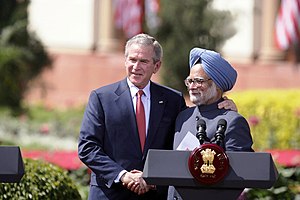The 123 Agreement signed between the United States of America and the Republic of India is known as the U.S.–India Civil Nuclear Agreement or Indo-US nuclear deal. The framework for this agreement was a July 18, 2005, joint statement by then Indian Prime Minister Manmohan Singh and then U.S. President George W. Bush, under which India agreed to separate its civil and military nuclear facilities and to place all its civil nuclear facilities under International Atomic Energy Agency (IAEA) safeguards and, in exchange, the United States agreed to work toward full civil nuclear cooperation with India. This U.S.-India deal took more than three years to come to fruition as it had to go through several complex stages, including amendment of U.S. domestic law, especially the Atomic Energy Act of 1954, a civil-military nuclear Separation Plan in India, an India-IAEA safeguards (inspections) agreement and the grant of an exemption for India by the Nuclear Suppliers Group, an export-control cartel that had been formed mainly in response to India's first nuclear test in 1974. In its final shape, the deal places under permanent safeguards those nuclear facilities that India has identified as "civil" and permits broad civil nuclear cooperation, while excluding the transfer of "sensitive" equipment and technologies, including civil enrichment and reprocessing items even under IAEA safeguards. On August 18, 2008 the IAEA Board of Governors approved, and on February 2, 2009, India signed an India-specific safeguards agreement with the IAEA. After India brought this agreement into force, inspections began in a phased manner on the 35 civilian nuclear installations India has identified in its Separation Plan. The deal is seen as a watershed in U.S.-India relations and introduces a new aspect to international nonproliferation efforts.[7] On August 1, 2008, the IAEA approved the safeguards agreement with India, after which the United States approached the Nuclear Suppliers Group] (NSG) to grant a waiver to India to commence civilian nuclear trade.The 48-nation NSG granted the waiver to India on September 6, 2008 allowing it to access civilian nuclear technology and fuel from other countries. The implementation of this waiver made India the only known country with nuclear weapons which is not a party to the Non-Proliferation Treaty (NPT) but is still allowed to carry out nuclear commerce with the rest of the world.
The U.S. House of Representatives passed the bill to approve the deal on September 28, 2008. Two days later, India and France inked a similar nuclear pact making France the first country to have such an agreement with India. On October 1, 2008 the U.S. Senate also approved the civilian nuclear agreement allowing India to purchase nuclear fuel and technology from—and sell them to—the United States. U.S. President, George W. Bush, signed the legislation on the Indo-US nuclear deal, approved by the U.S. Congress, into law, now called the United States-India Nuclear Cooperation Approval and Non-proliferation Enhancement Act, on October 8, 2008. The agreement was signed by then Indian External Affairs Minister Pranab Mukherjee and his counterpart then Secretary of State Condoleezza Rice, on October 10.
In 2015, the agreement had still not been fully implemented.
In 2016, the countries agreed to build 6 US-designed reactors in India
source- wikipedia

No comments:
Post a Comment